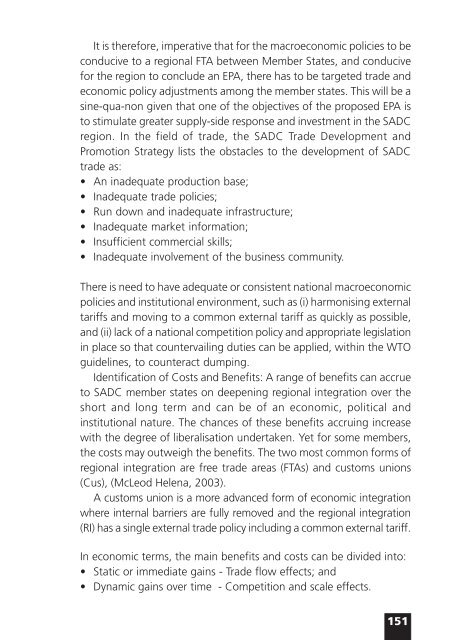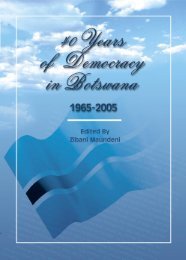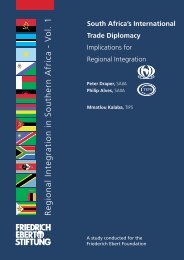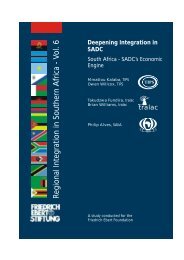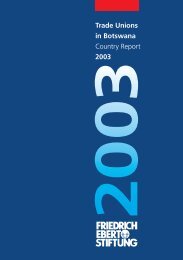Deepening Integration in SADC - Fes-botswana.org
Deepening Integration in SADC - Fes-botswana.org
Deepening Integration in SADC - Fes-botswana.org
Create successful ePaper yourself
Turn your PDF publications into a flip-book with our unique Google optimized e-Paper software.
It is therefore, imperative that for the macroeconomic policies to be<br />
conducive to a regional FTA between Member States, and conducive<br />
for the region to conclude an EPA, there has to be targeted trade and<br />
economic policy adjustments among the member states. This will be a<br />
s<strong>in</strong>e-qua-non given that one of the objectives of the proposed EPA is<br />
to stimulate greater supply-side response and <strong>in</strong>vestment <strong>in</strong> the <strong>SADC</strong><br />
region. In the field of trade, the <strong>SADC</strong> Trade Development and<br />
Promotion Strategy lists the obstacles to the development of <strong>SADC</strong><br />
trade as:<br />
An <strong>in</strong>adequate production base;<br />
Inadequate trade policies;<br />
Run down and <strong>in</strong>adequate <strong>in</strong>frastructure;<br />
Inadequate market <strong>in</strong>formation;<br />
Insufficient commercial skills;<br />
Inadequate <strong>in</strong>volvement of the bus<strong>in</strong>ess community.<br />
There is need to have adequate or consistent national macroeconomic<br />
policies and <strong>in</strong>stitutional environment, such as (i) harmonis<strong>in</strong>g external<br />
tariffs and mov<strong>in</strong>g to a common external tariff as quickly as possible,<br />
and (ii) lack of a national competition policy and appropriate legislation<br />
<strong>in</strong> place so that countervail<strong>in</strong>g duties can be applied, with<strong>in</strong> the WTO<br />
guidel<strong>in</strong>es, to counteract dump<strong>in</strong>g.<br />
Identification of Costs and Benefits: A range of benefits can accrue<br />
to <strong>SADC</strong> member states on deepen<strong>in</strong>g regional <strong>in</strong>tegration over the<br />
short and long term and can be of an economic, political and<br />
<strong>in</strong>stitutional nature. The chances of these benefits accru<strong>in</strong>g <strong>in</strong>crease<br />
with the degree of liberalisation undertaken. Yet for some members,<br />
the costs may outweigh the benefits. The two most common forms of<br />
regional <strong>in</strong>tegration are free trade areas (FTAs) and customs unions<br />
(Cus), (McLeod Helena, 2003).<br />
A customs union is a more advanced form of economic <strong>in</strong>tegration<br />
where <strong>in</strong>ternal barriers are fully removed and the regional <strong>in</strong>tegration<br />
(RI) has a s<strong>in</strong>gle external trade policy <strong>in</strong>clud<strong>in</strong>g a common external tariff.<br />
In economic terms, the ma<strong>in</strong> benefits and costs can be divided <strong>in</strong>to:<br />
Static or immediate ga<strong>in</strong>s - Trade flow effects; and<br />
Dynamic ga<strong>in</strong>s over time - Competition and scale effects.<br />
151


